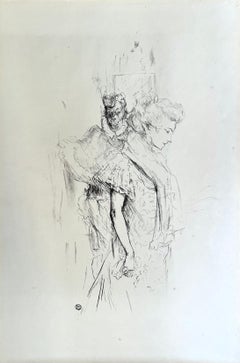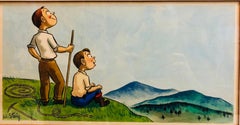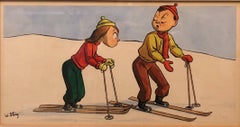(After) Henri Toulouse Lautrec Figurative Drawings and Watercolors
French, b. 1864
Henri de Toulouse-Lautrec (1864 – 1901) was a French painter, printmaker, draughtsman, caricaturist and illustrator whose immersion in the colourful and theatrical life of Paris in the late 19th century allowed him to produce a collection of enticing, elegant and provocative images of the modern, sometimes decadent, affairs of those times. Toulouse-Lautrec is among the best-known painters of the Post-Impressionist period, with Cézanne, Van Gogh and Gauguin.
As a young child, his parents separated after the death of his brother and a nanny eventually took care of him. At the age of eight, he went to live with his mother in Paris where he drew sketches and caricatures in his exercise workbooks. The family quickly realized that his talents lay in drawing and painting. Due to improper healing of two leg fractures, as an adult he was extremely short (4' 8"). He developed an adult-sized torso, while retaining his child-sized legs. Physically unable to participate in many activities enjoyed by males his age, Toulouse-Lautrec immersed himself in art. He became an important Post-Impressionist painter, Art Nouveau illustrator, and lithographer, and, through his works, recorded many details of the late-19th-century bohemian lifestyle in Paris.to
1
Overall Width
to
Overall Height
to
1
1
1
1
1
1
1
74
888
324
192
178
1
1
Artist: (After) Henri Toulouse Lautrec
Blanche et Noire
By (After) Henri Toulouse Lautrec
Located in Cliffside Park, NJ
Blanche et Noire, de l'album «Toulouse-Lautrec, douze lithographies»
52,2 x 35,9 cm
Category
1890s Naturalistic (After) Henri Toulouse Lautrec Figurative Drawings and Watercolors
Materials
Lithograph
Related Items
Whimsical Illustration Hiking Cartoon, 1938 Mt Tremblant Ski Lodge William Steig
By William Steig (b.1907)
Located in Surfside, FL
Lighthearted Illustration of Outdoor Pursuits This one being cross country hiking signed "W. Steig"
Provenance: from Mrs. Joseph B. Ryan, Commissioned by Joe Ryan for the bar at his ski resort, Mount Tremblant Lodge, in 1938.
Mont Tremblant, P.Q., Canada
Watercolor and ink on illustration board, sights sizes 8 1/2 x 16 1/2 in., framed.
In 1938 Joe Ryan, described as a millionaire from Philadelphia, bushwhacked his way to the summit of Mont Tremblant and was inspired to create a world class ski resort at the site. In 1939 he opened the Mont Tremblant Lodge, which remains part of the Pedestrian Village today. This original illustration is on Whatman Illustration board. the board measures 14 X 22 inches. label from McClees Galleries, Philadelphia, on the frame backing paper.
William Steig, 1907 – 2003 was an American cartoonist, sculptor, and, in his later life, an illustrator and writer of children's books. Best known for the picture books Sylvester and the Magic Pebble, Abel's Island, and Doctor De Soto, he was also the creator of Shrek!, which inspired the film series of the same name. He was the U.S. nominee for both of the biennial, international Hans Christian Andersen Awards, as a children's book illustrator in 1982 and a writer in 1988.
Steig was born in Brooklyn, New York in 1907, and grew up in the Bronx. His parents were Polish-Jewish immigrants from Austria, both socialists. His father, Joseph Steig, was a house painter, and his mother, Laura Ebel Steig, was a seamstress who encouraged his artistic leanings. As a child, he dabbled in painting and was an avid reader of literature. Among other works, he was said to have been especially fascinated by Pinocchio.He graduated from Townsend Harris High School at 15 but never completed college, though he attended three, spending two years at City College of New York, three years at the National Academy of Design and a mere five days at the Yale School of Fine Arts before dropping out of each.
Hailed as the "King of Cartoons" Steig began drawing illustrations and cartoons for The New Yorker in 1930, producing more than 2,600 drawings and 117 covers for the magazine. Steig, later, when he was 61, began writing children's books. In 1968, he wrote his first children's book. He excelled here as well, and his third book, Sylvester and the Magic Pebble (1969), won the Caldecott Medal. He went on to write more than 30 children's books, including the Doctor DeSoto series, and he continued to write into his nineties. Among his other well-known works, the picture book Shrek! (1990) formed the basis for the DreamWorks Animation film Shrek (2001). After the release of Shrek 2 in 2004, Steig became the first sole-creator of an animated movie franchise that went on to generate over $1 billion from theatrical and ancillary markets after only one sequel. Along with Maurice Sendak, Saul Steinberg, Ludwig Bemelmans and Laurent de Brunhofff his is one of those rare cartoonist whose works form part of our collective cultural heritage.
In 1984, Steig's film adaptation of Doctor DeSoto directed by Michael Sporn was nominated for the Academy Award for Best Animated Short Film. As one of the most admired cartoonists of all time, Steig spent seven decades drawing for the New Yorker magazine. He touched generations of readers with his tongue–in–cheek pen–and–ink drawings, which often expressed states of mind like shame, embarrassment or anger. Later in life, Steig turned to children's books, working as both a writer and illustrator.
Steig's children's books were also wildly popular because of the crazy, complicated language he used—words like lunatic, palsied, sequestration, and cleave. Kids love the sound of those words even if they do not quite understand the meaning. Steig's descriptions were also clever. He once described a beached whale as "breaded with sand."
Throughout the course of his career, Steig compiled his cartoons and drawings into books. Some of them were published first in the New Yorker. Others were deemed too dark to be printed there. Most of these collections centered on the cold, dark psychoanalytical truth about relationships. They featured husbands and wives fighting and parents snapping at their kids. His first adult book, Man About Town, was published in 1932, followed by About People, published in 1939, which focused on social outsiders. Sick of Each Other, published in 2000, included a drawing depicting a wife holding her husband at gunpoint, saying, "Say you adore me."
According to the Los Angeles Times, fellow New Yorker artist Edward Sorel...
Category
1930s Naturalistic (After) Henri Toulouse Lautrec Figurative Drawings and Watercolors
Materials
Archival Ink, Watercolor, Illustration Board
Whimsical Illustration Skiing Cartoon, 1938 Mt Tremblant Ski Lodge William Steig
By William Steig (b.1907)
Located in Surfside, FL
Lighthearted Illustration of Outdoor Pursuits This one being a Skiing scene, a boy and a girl on skis. signed W. Steig
Provenance: from Mrs. Joseph B. Ryan, Commissioned by Joe Ryan for the bar at his ski resort, Mount Tremblant Lodge, in 1938.
Mont Tremblant, P.Q., Canada
Watercolor and ink on illustration board, sights sizes 8 1/2 x 16 1/2 in., framed.
In 1938 Joe Ryan, described as a millionaire from Philadelphia, bushwhacked his way to the summit of Mont Tremblant and was inspired to create a world class ski resort at the site. In 1939 he opened the Mont Tremblant Lodge, which remains part of the Pedestrian Village today. This original illustration is on Whatman Illustration board. the board measures 14 X 22 inches. label from McClees Galleries, Philadelphia, on the frame backing paper.
William Steig, 1907 – 2003 was an American cartoonist, sculptor, and, in his later life, an illustrator and writer of children's books. Best known for the picture books Sylvester and the Magic Pebble, Abel's Island, and Doctor De Soto, he was also the creator of Shrek!, which inspired the film series of the same name. He was the U.S. nominee for both of the biennial, international Hans Christian Andersen Awards, as a children's book illustrator in 1982 and a writer in 1988.
Steig was born in Brooklyn, New York in 1907, and grew up in the Bronx. His parents were Polish-Jewish immigrants from Austria, both socialists. His father, Joseph Steig, was a house painter, and his mother, Laura Ebel Steig, was a seamstress who encouraged his artistic leanings. As a child, he dabbled in painting and was an avid reader of literature. Among other works, he was said to have been especially fascinated by Pinocchio.He graduated from Townsend Harris High School at 15 but never completed college, though he attended three, spending two years at City College of New York, three years at the National Academy of Design and a mere five days at the Yale School of Fine Arts before dropping out of each.
Hailed as the "King of Cartoons" Steig began drawing illustrations and cartoons for The New Yorker in 1930, producing more than 2,600 drawings and 117 covers for the magazine. Steig, later, when he was 61, began writing children's books. In 1968, he wrote his first children's book. He excelled here as well, and his third book, Sylvester and the Magic Pebble (1969), won the Caldecott Medal. He went on to write more than 30 children's books, including the Doctor DeSoto series, and he continued to write into his nineties. Among his other well-known works, the picture book Shrek! (1990) formed the basis for the DreamWorks Animation film Shrek (2001). After the release of Shrek 2 in 2004, Steig became the first sole-creator of an animated movie franchise that went on to generate over $1 billion from theatrical and ancillary markets after only one sequel. Along with Maurice Sendak, Saul Steinberg, Ludwig Bemelmans and Laurent de Brunhofff his is one of those rare cartoonist whose works form part of our collective cultural heritage.
In 1984, Steig's film adaptation of Doctor DeSoto directed by Michael Sporn was nominated for the Academy Award for Best Animated Short Film. As one of the most admired cartoonists of all time, Steig spent seven decades drawing for the New Yorker magazine. He touched generations of readers with his tongue–in–cheek pen–and–ink drawings, which often expressed states of mind like shame, embarrassment or anger. Later in life, Steig turned to children's books, working as both a writer and illustrator.
Steig's children's books were also wildly popular because of the crazy, complicated language he used—words like lunatic, palsied, sequestration, and cleave. Kids love the sound of those words even if they do not quite understand the meaning. Steig's descriptions were also clever. He once described a beached whale as "breaded with sand."
Throughout the course of his career, Steig compiled his cartoons and drawings into books. Some of them were published first in the New Yorker. Others were deemed too dark to be printed there. Most of these collections centered on the cold, dark psychoanalytical truth about relationships. They featured husbands and wives fighting and parents snapping at their kids. His first adult book, Man About Town, was published in 1932, followed by About People, published in 1939, which focused on social outsiders. Sick of Each Other, published in 2000, included a drawing depicting a wife holding her husband at gunpoint, saying, "Say you adore me."
According to the Los Angeles Times, fellow New Yorker artist Edward Sorel...
Category
1930s Naturalistic (After) Henri Toulouse Lautrec Figurative Drawings and Watercolors
Materials
Archival Ink, Watercolor, Illustration Board
French Nude Woman Seated on a Bench Study
By Emile Lejeune
Located in Houston, TX
Nude woman seated on a bench looking out at the viewer. The work is signed by the artist and stamped. The paper is not framed.
Many others are available. Please inquire to buy the e...
Category
1950s Naturalistic (After) Henri Toulouse Lautrec Figurative Drawings and Watercolors
Materials
Graphite
Early Portrait of a French Woman
By Emile Lejeune
Located in Houston, TX
Naturalistic portrait of a french woman with a styled hair cut. The work is signed and dated by the artist. The paper is not framed.
Many others are available. Please inquire to buy the entire collection.
Artist Biography: Emile Lejeune...
Category
1930s Naturalistic (After) Henri Toulouse Lautrec Figurative Drawings and Watercolors
Materials
Color Pencil, Graphite
Reclining Naturalistic Nude Woman Study
By Emile Lejeune
Located in Houston, TX
Reclining nude study of a woman with her leg up on the bed and her eyes closed. The work is signed by the artist. The paper is not framed.
Many others are available. Please inquire ...
Category
1950s Naturalistic (After) Henri Toulouse Lautrec Figurative Drawings and Watercolors
Materials
Graphite
Untitled Naturalistic Portrait of a Musician
By Stanley Clark
Located in Houston, TX
Untitled naturalist portrait of a musician with a guitar. The work is signed by the artist in the bottom corner and the work is not currently framed.
Art...
Category
Late 20th Century Naturalistic (After) Henri Toulouse Lautrec Figurative Drawings and Watercolors
Materials
Charcoal
Naturalistic Nude Laying on Bed Study
By Emile Lejeune
Located in Houston, TX
Study of a nude woman laying on a bed with her leg up on the bed. She is facing away from the viewer. The work is signed and dated by the artist. The paper is not framed.
Many other...
Category
1940s Naturalistic (After) Henri Toulouse Lautrec Figurative Drawings and Watercolors
Materials
Graphite
Naturalistic Study of a Standing Nude Woman
By Emile Lejeune
Located in Houston, TX
A naturalistic study of a nude woman standing with her back to the viewer. She appears to be gripping the corner of something. The work is signed and dated by the artist. The paper is not framed.
Many others are available. Please inquire to buy the entire collection.
Artist Biography: Emile Lejeune...
Category
1950s Naturalistic (After) Henri Toulouse Lautrec Figurative Drawings and Watercolors
Materials
Graphite
$1,200
H 18.88 in W 12.38 in D 0.001 in
[CHINESE EXPORT WATERCOLOURS ON PITH PAPER]. - Botanical Studies
Located in London, GB
[CHINESE EXPORT WATERCOLOURS ON PITH PAPER].
A Group of 10 Flowers and Butterflies.
mid to late nineteeenth century.
A fine group of Chines...
Category
Late 19th Century Naturalistic (After) Henri Toulouse Lautrec Figurative Drawings and Watercolors
Materials
Watercolor, Gouache, Rice Paper
$19,310
H 10.63 in W 15.56 in D 0.79 in
Naturalistic Watercolor European Harbor Scene
Located in Houston, TX
Naturalistic European harbor scene with boats and figures preparing the boats of sailing. The work is signed and dated by the artist in the bottom corner. The paper comes with a blac...
Category
1890s Naturalistic (After) Henri Toulouse Lautrec Figurative Drawings and Watercolors
Materials
Watercolor
Dancing Figurative Study of a Nude Woman
By Thierry Andre
Located in Houston, TX
Figurative study of a dancing woman. The work is signed by Thierry Andre thought to be a French who was influenced by Edgar Degas. The paper is not fr...
Category
1960s Naturalistic (After) Henri Toulouse Lautrec Figurative Drawings and Watercolors
Materials
Graphite
Naturalistic Portrait of a French Woman
By Emile Lejeune
Located in Houston, TX
An excellent portrait of french women looking straight out at the viewer. The work is signed by the artist. The paper is not framed.
Many oth...
Category
1950s Naturalistic (After) Henri Toulouse Lautrec Figurative Drawings and Watercolors
Materials
Color Pencil, Graphite
(after) Henri Toulouse Lautrec figurative drawings and watercolors for sale on 1stDibs.
Find a wide variety of authentic (After) Henri Toulouse Lautrec figurative drawings and watercolors available for sale on 1stDibs. You can also browse by medium to find art by (After) Henri Toulouse Lautrec in lithograph and more. Not every interior allows for large (After) Henri Toulouse Lautrec figurative drawings and watercolors, so small editions measuring 13 inches across are available. (After) Henri Toulouse Lautrec figurative drawings and watercolors prices can differ depending upon medium, time period and other attributes. On 1stDibs, the price for these items starts at $15,000 and tops out at $15,000, while the average work can sell for $15,000.
Questions About (After) Henri Toulouse Lautrec Figurative Drawings and Watercolors
- 1stDibs ExpertFebruary 21, 2024Toulouse Lautrec's paintings are in many locations around the world. Home to more than 1,000 of the artist's works, the Musée Toulouse-Lautrec in Albi, France, has the largest collection. You can also find paintings in the collections of the Art Institute of Chicago in Chicago, Illinois; the Hermitage Museum in St. Petersburg, Russia; the Museum of Modern Art in New York City, New York; and in many other major museums. Explore a range of Henri de Toulouse-Lautrec art on 1stDibs.
- 1stDibs ExpertApril 5, 2022Henri de Toulouse-Lautrec was a painter, drawer and print-maker. One of his most recognizable works is the ‘Moulin Rouge: La Goulue’, which is a four-color lithograph depicting the famous can-can dancer La Goulue. Shop a selection of Henri de Toulouse-Lautrec’s pieces from some of the world’s top art dealers on 1stDibs.
- Is Toulouse-Lautrec Art Deco?1 Answer1stDibs ExpertApril 5, 2022The work of French artist Henri de Toulouse-Lautrec falls into the Art Nouveau style, which was prevalent approximately during the period of 1890-1910. Following the Art Nouveau period was the Art Deco era, which is usually defined as the era between 1920 and 1930. Toulouse-Lautrec died in 1901 putting his art in the era of Art Nouveau, but certain aspects of it definitely hint at the coming Art Deco style considering the definite overlap of the two movements. On 1stDibs, find a variety of original artwork from top artists.


